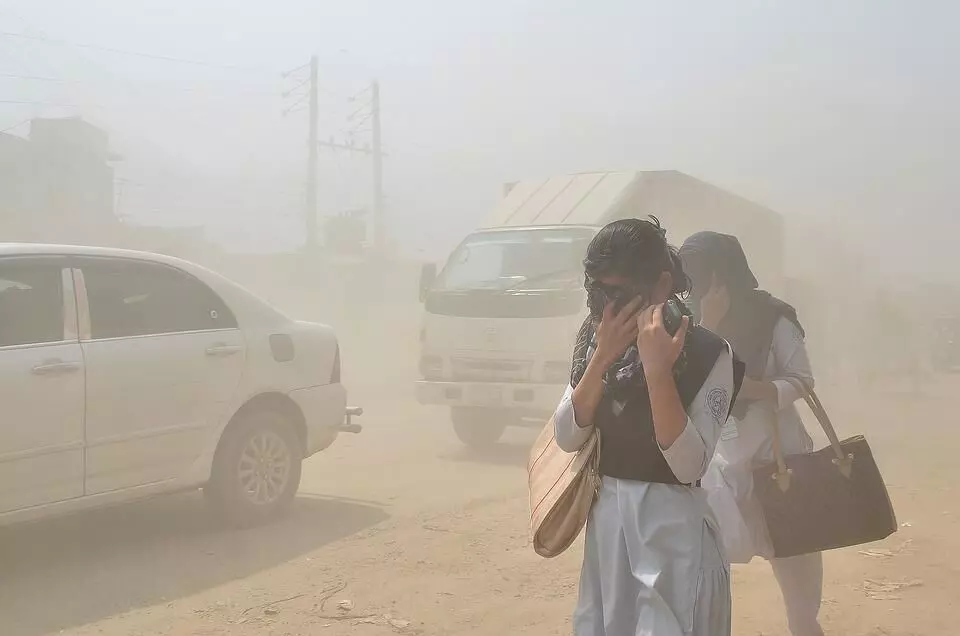Heart Under Attack: A new study links exposure to air pollutants to cardiovascular diseases
A recent study undertaken in West Bengal by Climate Trends and IIT Delhi shows a higher prevalence of upper and lower respiratory illnesses and cardiovascular problems as a result of long and long and short term exposures to air pollutants. Women in the state's rural areas were more vulnerable to it.
 गाँव कनेक्शन 26 July 2022 11:16 AM GMT
गाँव कनेक्शन 26 July 2022 11:16 AM GMT

Prolonged exposure of these pollutants could lead to a host of respiratory diseases. Photo: Pixabay
Air pollution has been recognised as the world's largest environmental health risk. It is also the leading cause of deaths in India with an estimated 1.67 million deaths reported due to air pollution in 2019 alone.
A recent study published last week on July 23 that analysed data in West Bengal shows PM2.5 levels were higher in the urban regions compared to rural areas. This study titled Health Effects of Short and Long term Air Pollution Exposure also aimed to explore the short and long term effects of PM2.5 on upper and lower respiratory symptoms in the urban and rural population.
An adult human being takes in about 15,000 litres of air every day. The primary target of all sorts of pollutants inhaled is the lungs and the airways. Prolonged exposure of these pollutants could lead to a host of respiratory diseases that are manifested by some specific upper respiratory symptoms (URS) and lower respiratory symptoms (LRS).
In both urban and rural populations, the prevalence of upper respiratory symptoms including sinusitis, sore throat, runny or stuffy nose and sneezing, was higher than that of lower respiratory symptoms that include wet or dry cough, wheeze, laboured breathing, and chest tightness. LRS was found to be more serious in nature than URS and was more common in urban areas.
Hypertension was found to be the most common in both urban and rural settings. Hypertension that showed positive association with PM2.5 levels is a known risk factor for cardiovascular disease including heart attacks and stroke.
The joint study conducted by Climate Trends and Indian Institute of Technology (IIT) Delhi is based on a field-survey conducted across seven regions of West Bengal – Kolkata, Howrah, Asansol, Haldia, Barrackpore, Bardhhaman and Barasat – to assess the ground-level impact of air pollution on public health. All study locations recorded average PM 2.5 exposure above the Central Pollution Control Board's annual safety limits of 40 µg/m3.
"The study reveals that the air pollution impact is far beyond the urban pockets as both rural and urban populations in West Bengal are affected. We need an integrated airshed approach focussing on inter-sectoral coordination to address air pollution issues. Health needs to be linked to a clean air action plan to assess the efficacy of intervention measures. No clean air targets can be achieved without interstate coordination and airshed management," Sagnik Dey, Professor from IIT Delhi, was quoted in a press statement dated July 23.
Cooking with biomass adds fuel to the fire
Globally, around 2.8 billion people rely on solid fuels such as wood, dung, coal and crop residue for cooking and space heating. The 2011 census data shows 780 million of them are from India where the residents are mostly rural.
In simple traditional cookstoves, biomass (wood, dung, crop residue), burning during cooking produces a range of toxic products including PM2.5 which is roughly equal to burning about 400 cigarettes an hour, pointed out the study. A large number of women and children who tend to be in the kitchen are exposed to this source of pollution.
Meanwhile, occupation also emerged as an important determinant of air pollution-related adverse health outcomes. As the transport sector represents an important contributor to outdoor air pollution, especially in urban settings, people with higher exposure to vehicular emissions such as traffic policemen, roadside hawkers, garage workers, drivers of motorized vehicles, suffered more.
Professionals were more affected by air pollution exposure in both the regions compared to entrepreneurs and workers. Professionals were more vulnerable in urban regions like workers were more vulnerable in rural areas.
For URS, professionals (48.6 per cent) developed higher health outcomes than other occupational categories, especially in rural areas.
In rural regions, strong associations were found in workers for tachycardia, hypertension, and asthama. The risks for Chronic Obstructive Pulmonary Disease, Lower Respiratory Infection, and diabetes were similar in different occupational groups, but the risks were relatively higher in the rural population. In both women and men, Chronic Obstructive Pulmonary Disease was marginally higher in rural than in urban.
Persons above 50 years of age displayed the highest prevalence of lower respiratory symptoms both in rural (8.36 per cent) and urban (eight per cent) areas.
#Air Pollution #Story
More Stories




